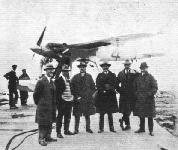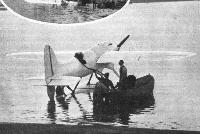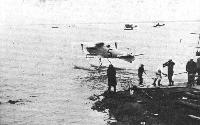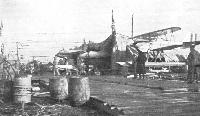Supermarine. Гоночные самолеты
<...>
Для гонки 1925 года в Балтиморе Реджинальд Митчел создал обтекаемый цельнодеревянный гидросамолет-моноплан S.4, оснащенный 700-сильным (522 кВт) ПД Napier Lion, но тот был разбит во время испытаний.
<...>
Показать полностьюShow all
Flight, September 1925
THE SCHNEIDER CUP SEAPLANE RACE
THE MACHINES
THE SUPERMARINE-NAPIER S.4
Actually the Gloucestershire Aircraft Company has built two machines, which are identical except for certain very minor details. Both of these will be sent across, and, in addition, the Gloucestershire "Bamel," which has been used by the pilots for training purposes, will also go over to be used by the pilots for practising over the actual course of the race. The Supermarine Aviation Works have not had time to build a reserve machine, but with the two Gloucestershire biplanes there should be little fear of Great Britain not being adequately represented in the. race.
On Thursday of last week representatives of the press had an opportunity of inspecting the Supermarine-Napier S.4 at the Woolston works of the Supermarine Aviation Works. Owing to the congested nature of the River Itchen it was not found possible to give a demonstration flight with the machine, but the Napier engine was run up with the machine standing on the slipways, and gave an excellent impression of power, the silky smoothness with which the engine accelerated being most remarkable, and the note emitted at full throttle being very reassuring. In connection with the sound of the engine, it is of interest to note that Capt. Biard found that at full throttle he could barely hear his engine, all he heard being a relatively faint hum, such as one may hear upon standing in or close to an electric power station. Why this should be so is difficult to explain, but apparently at the very high speed corresponding to full throttle the sound is deflected by the turbulence in the air immediately surrounding the fuselage.
The Supermarine-Napier S.4 is an exceptionally fine piece of work from every point of view, and at first sight one cannot help feeling a certain amount of surprise that a British designer has had sufficient imagination to produce such a machine. Perhaps one may describe the Supermarine-Napier S.4 as having the appearance of having been designed in an inspired moment, but having all that is considered best in British construction incorporated in its details. That the design is bold, no one will deny, and we think the greatest credit is due to Mr. R. J. Mitchell, chief designer of the Supermarine Aviation Works, for his courage in breaking away from stereotyped methods and striking out on entirely novel lines. When it is remembered that Mr. Mitchell has hitherto almost exclusively devoted his attention to the flying-boat biplane, it is little short of astonishing that he should have been able so entirely to break away from the types with which he has been so intimately connected for the past seven or eight years, and not only abandon the flying-boat type in favour of the twin-float arrangement, but actually change from the braced-biplane structure to the pure cantilever wing of the S.4.
Bearing in mind the radical change of design which was involved, it is of considerable interest to note that instructions to proceed with the construction of this machine were issued on March 18, 1925, and the first test flight was carried out on August 25. Apart from certain very minor changes, no alterations have been found necessary, a fact which speaks volumes for Mr. Mitchell's ability as a designer.
The photographs on page 611 are, we regret to say, of very poor quality, and do not by any means do justice to the machine. They were, apparently, secured by an official photographer from the Air Ministry, and it cannot be said that they are a credit to the department. However, so "secret" had the Air Ministry held the machine that our photographer was not allowed to take any photographs, otherwise we should have been able to give a better idea of the really beautiful lines of the Supermarine-Napier S.4.
The S.4 is of exceptionally clean design, and the construction is mainly wood, no fabric being used for covering either in the fuselage or on the wings. The fuselage is built in two sections, of which the front portion is a steel tube structure, while the rear portion is a wooden monocoque. The front portion is covered with wood so as to form, with the rear wood portion, a perfect streamline shape, and the fin and tail plane are built integral with the fuselage and covered with ply-wood. All controls are carried inside the structure, rigid tubular rods being employed in place of cable and the ailerons being operated by torque tubes. The pilot's cockpit is placed very far aft in the fuselage and although the view is not perhaps all that could be desired for landing, the position is such as to make for safety, and should the machine accidentally turn over in the sea there is nothing to obstruct the pilot's exit.
The cantilever monoplane wing is built in one piece, and is of symmetrical bi-convex section, the section being one recently developed by the Royal Aircraft Establishment at Farnborough and having a high L/D value at small angles of attack.
At first sight it seems somewhat daring to choose a cantilever monoplane wing for such a fast machine, but we gather that a trial wing was constructed and was tested to destruction at Farnborough, where the factors of safety were found to be adequate. In order slightly to reduce the landing speed, the whole trailing edge of the monoplane wing is hinged and used as a camber gear, and in this form the maximum lift coefficient of the section is, we believe, reasonably high, so that the combination of symmetrical section and trailing edge flaps should be particularly good at both ends of the speed scale.
The special Napier engine is mounted in the nose of the fuselage, and is entirely cowled in, each cylinder bank having an aluminium cowl over it where it projects through the main covering. A Fairey-Read duralumin propeller is fitted, and some idea of the speed at which the Napier racing engine runs may be formed when it is stated that the tip speed of the propeller is slightly higher than that of sound.
A small spinner surrounds the propeller boss, and as there is no nose radiator the entry for the air is about as clean as is possible to provide. Special Lamblin radiators are fitted under the lower surface of the wing, extending outwards about 6 ft. on each side.
One of the most daring features of the design of the Supermarine Napier S.4 is the undercarriage, in which Mr. Mitchell has employed unbraced high tensile steel tubes of circular section. These tubes are triangulated at the top to the fuselage steel tube structure and at their lower ends to the special tubular bracing inside the floats. They are braced laterally by two horizontal tubes, but there is no wire bracing of any sort, so that the steel tubes are free to deflect both fore and aft and laterally. This gives a quite surprising amount of elasticity to the undercarriage structure, which, during the test flights over Southampton Water and the Solent, was found to stand up to the work extremely well. The two floats of the Supermarine-Napier S.4 are of the single-step type, and are built entirely of wood.
During the visit to the Southampton works, Commander James Bird, Managing Director of the company, briefly explained the manner in which the Supermarine-Napier S.4 came into being, and stated that although the race was by no means going to be a "walk-over," for the British representatives, he did feel fairly confident that the two British challengers would at any rate have a sporting chance. He also referred to the fact that none of the Supermarine directors would be going over to the race, but that it had been decided to send Mr. Mitchell instead, and he thought this would be a wise step since, if test flights on the other side made Captain Biard wish for any modifications to be carried out, Mr. Mitchell would be the man best able to decide if such modifications were advisable. Commander Bird also expressed his thanks to the CO., and all officers and ranks at the R.A.F. station at Calshot for the valuable assistance which had been given during the carrying out of the flying tests of the machine, and but for their timely assistance it would have been impossible to have carried out these tests as quickly and as successfully as had been done.
The Supermarine team will include, in addition to Captain Biard, the pilot of the machine, Mr. R. J. Mitchell, Chief engineer and designer ; Mr. A. Powell, in charge of erection, Mr. H. B. Pickett, engine mechanic, Mr. G. H. Broome, rigger, and Mr. H. M. Grimes, launchman.
Показать полностьюShow all













